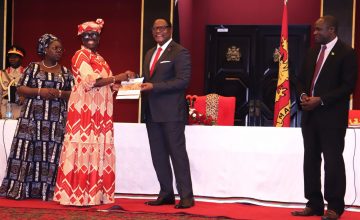Climate-smart farmers go dirty
After decades of consistently applying chemical fertilisers in her maize field, Rose Dailo was puzzled that yields kept shrinking.
“Obviously, the soil was tired; it couldn’t take anymore fertiliser,” states the lead farmer in Simon Village, Traditional Authority Chikowi in Zomba. “Only fertiliser costs were rising.”
She soon discovered that the once spongy, fertile crop field had become a hardpan where whirlwinds and running rainwater easily swept topsoil away.

“By then, an acre that once gave me 27 bags weighing 50 kilogrammes [kg] each could only produce less than 10 bags,” she recalls.
The shock prompted Dailo to start using mbeya, a mix of chemical fertiliser with ash, bran and pig droppings.
Dirty but smart
Now she gets dirty in a shade, fashioning the homemade fertiliser by mixing 10kgs of fertiliser from shops with a 20-litre bucketful of maize bran, ash and pig or chicken waste on a plastic sheeting or toupline.
During a visit to her home, she was seen soaking the mixture using a watering can until it was evenly wet, then mixed it thoroughly using bare hands and only stopped when a measure firmly squeezed in her clenched fist released no drop of water. Then, she loaded the brownish mix into a sack with plastic lining, tied airtight to be stored in a shade for 21 days to cool down, ready for use.
“Just like that, a 50kgs bag of fertiliser produces four more. Mbeya isn’t not your usual manure, but potent fertiliser which heals the soil. It is less costly, makes the soil fertile and spongy again, boosts crop health and yields,” Dailo states, while tying the bag tightly.
She learnt the skills from National Smallholder Farmers Association of Malawi (Nasfam) field officers. This is part of a climate-smart agriculture project the association is running with funding from Irish Aid to ensure smallholder farmers harvest more from their plots amid climate-related weather shocks.
The lead farmer shares the knowledge with growers she mentors on high-yielding farming techniques.
“Some accepted it, but others didn’t. But I will not relent because the benefits are clear. A half-acre field that used to give me just 12 bags in 2010 now produces 48,” she counts the gains.
Investing less, harvesting more
The turnaround and dedication made her one of the three farmers who spoke at a farmers’ conference in the capital, Lilongwe, last year.
Nasfam supported her epic trip.
She implores farmers concerned about skyrocketing fertiliser prices to try mbeya instead of blowing their savings on bags worth K40 000 each.
“The idea is to invest less and harvest more as we receive little rain which begins too late for crops and disappears fast,” she says. “Mbeya retains soil moisture and fertility, keeping the crops green for a longer time.”
In 2020, she sold three 50kg bags of Mbeya at K8 000 each.
She used the money to send children to school and employ pieceworkers to remove weeds from her fields where yields have quadrupled.
“While my friends were whining about hunger, I had adequate food throughout the year. In fact, I donated a bag to a community-based childcare centre in the vicinity and sold the remaining stack at a bigger profit during the hunger season when demand for grain was high,” she explains.
From the proceeds of maize sales, she donated pens, notebooks and pencils to adult literacy and numerous sessions supported by Nasfam.
“As a former supervisor of the initiative, I know that when adults realise the importance of education, their burning desire to learn to read, write and count shouldn’t be killed by lack of basics. They should learn and improve their livelihoods,” Dailo explains.
She doesn’t spend much to reap more because mbeya is made of locally available goods.
“I get them from an everyday activity: cooking meals morning, noon and evening. The bran comes from the maize flour we eat daily. The stools emanate from waste from the animals we rear. I only buy a bag or two of fertiliser,” she puts it in context.
And the once breached dry soils now look blackish with consistent use of mbeya.
“The soils once degraded by chemical fertilisers are now fertile again and the crop looks healthy and resilient to dry spells,” says the woman.
She plans to buy an oxcart for carrying the new fertiliser and bulging farm produce.
John Mandala, Nasfam field officer in Ngwelero Association, says Dailo’s insistence on mbeya offers farmers numerous lessons on why they need to embrace new techniques amid climate change.
“The association comprises about 2 000 farmers affiliated to 200 clubs, but dedicated lead farmers like Dailo’s main field and roadside demonstration plot remind onlookers that as climate gets trickier, we cannot continue farming as our grandparents used to before rainfall became unpredictable,” he states.
A learner’s experience
Rosemary Moses, her 48-year-old emulator, grows maize nourished by mbeya on one of her three-acre fields, also dotted with soya beans, groundnuts, pigeon peas and millet.
“I buy just one bag of fertiliser or two, so I save money for other basic needs. In this way, I yield 27 bags from the acre that could only produce 10 five years ago,” says the mother of seven.
Her mentor bought three goats, but now has a herd of five; the five chickens have multiplied to 17 and five pigs remain after selling another five. The pigs have become handy in mbeya production as they produce droppings rich in nutrients she needs to boost harvests in her maize and tomato fields.





